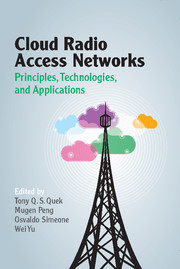Book contents
- Frontmatter
- Contents
- Acknowledgments
- Foreword
- Preface
- List of Contributors
- Part I Architecture of C-RANs
- 1 Overview of C-RAN
- 2 Advanced C-RAN for Heterogeneous Networks
- Part II Physical-Layer Design in C-RANs
- Part III Resource Allocation and Networking in C-RANs
- Part IV Networking in C-RANs
- Index
- References
1 - Overview of C-RAN
from Part I - Architecture of C-RANs
Published online by Cambridge University Press: 23 February 2017
- Frontmatter
- Contents
- Acknowledgments
- Foreword
- Preface
- List of Contributors
- Part I Architecture of C-RANs
- 1 Overview of C-RAN
- 2 Advanced C-RAN for Heterogeneous Networks
- Part II Physical-Layer Design in C-RANs
- Part III Resource Allocation and Networking in C-RANs
- Part IV Networking in C-RANs
- Index
- References
Summary
Introduction
In 2008, as the specification for long-term evolution (LTE) Release 8 was frozen in the Third Generation Partner Project (3GPP), operators began to shift the network deployment focus to 4G. In 2009, the world's first commercial LTE network was launched by TeliaSonera in Norway and Sweden. As of today, there are several hundred LTE networks in operation, providing unprecedented user experiences to customers. Consequently, we are witnessing the recent mobile traffic explosion in the telecom industry. It is expected that by 2020 consumer Internet traffic will increase by a factor of over one thousand [1].
As operators roll out and expand 4G networks, more and more challenges arise. First, network deployment is becoming more and more difficult simply due to an insufficient number of equipment rooms. Traditional base stations (BSs) comprise either a co-located baseband unit (BBU) with a radio unit or a distributed BBU with a remote radio unit (RRU) connected via fiber. For either case, a separate equipment room with supporting facilities such as air conditioning is required in order for BS deployment. However, since the operating frequency of LTE is usually higher than that of 2G and 3G, the coverage of an LTE cell is smaller than that of a 2G or 3G cell. As a result, more LTE cells are needed to cover the same area, meaning that more equipment rooms are required. Unfortunately, this is increasingly difficult since available real estate is becoming scarcer and more expensive. Traditional deployment puts a lot of pressure on capital expenditure (CAPEX).
Second, in a society where people are promoting energy conservation and environment protection, power consumption has become a sensitive word and a major concern for operators. It is estimated that the carbon footprint of the ICT industry accounts for 2% of the global total, which is the same as that of the aviation industry. For the telecom industry, further analysis has shown that a large percentage of power consumption in mobile networks comes from radio access networks (RANs) [1, 2]. Take China Mobile's networks, for example. The largest mobile network in the world consumed over 14 billion kWh of energy in 2012 in its network of 1.1 million base stations. It can be seen that saving energy in RANs could directly lower the operating expense (OPEX) of the network.
Information
- Type
- Chapter
- Information
- Cloud Radio Access NetworksPrinciples, Technologies, and Applications, pp. 3 - 11Publisher: Cambridge University PressPrint publication year: 2017
